Magnetic resonance (MR) imaging has become the workhorse in the imaging evaluation of the painful or clinically abnormal hip. It provides an excellent anatomic overview and demonstration of the bony structures, articular surfaces, and surrounding soft tissues. Conversely, sonography can also demonstrate superficial intraarticular structures and the periarticular soft tissues, is quickly performed, allows dynamic evaluation of tendons and muscles, and can guide percutaneous procedures. These two modalities are complementary, and this article concentrates on the MR imaging–sonographic correlations of several entities about the hip.
Key Points
- •
Magnetic resonance imaging and ultrasound are complimentary.
- •
Ultrasound can dynamically assess structures and can guide interventional procedures.
Intra-articular evaluation
A hip joint effusion is one of the most common signs of pathologic conditions in both the native and prosthetic hip, but what constitutes an effusion in terms of capsular distention is debated. Koski defined capsular distention as 7 mm or more, measuring the distance between the femoral neck and the anterior joint capsule, or a difference of 1 mm between both hips as a joint effusion. Bierma and colleagues found a higher correlation with clinical symptoms using the criterion of 1-mm difference in capsular distention between hips. This finding was true even when using the higher measure for joint effusion of 9 mm as defined by Sada and colleagues, who found 9 mm was the largest measurement in their study of 110 healthy adults. Sada and colleagues found a mean difference of 0.42 mm between hips in their healthy adult population.
Measurements of effusion in symptomatic hips in children have ranged from 4.7 mm to 9.9 mm. Tien and colleagues measured the synovial recesses of both hips in 748 healthy kindergarten-aged children and found that the measurements differed depending on patient positioning and used a standardized extended hip and knee position. In this position, they found a mean difference in the same child of 0.61 ± 0.52 mm. Because 95% of the differences should be 1.46 mm or less in their study, they concluded that if the difference between hips is greater than 1.46 mm, joint effusion should be highly suspected ( Fig. 1 ).
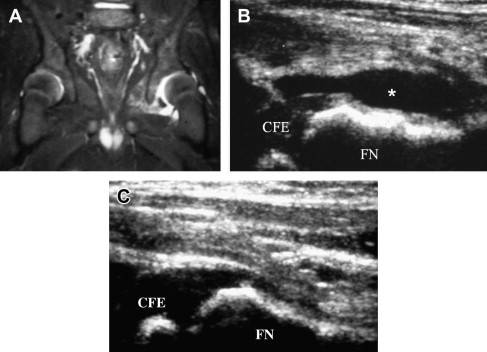
Tarasevicius and colleagues studied 27 patients undergoing arthroplasty measuring from the anterior neck of the femoral component to the anterior wall of the joint capsule. At 6 months in patients who had undergone posterior soft tissue repair, the recess measured 1.695 cm (SD 0.25 cm). In patients who had not undergone posterior soft tissue repair, it measured 1.347 cm (SD 0.30 cm). After 12 months, the median capsular distension was 1.406 cm (SD 0.33 cm) and 1.202 cm (SD 0.36 cm), ( P = .11), respectively. Földes and colleagues reported a sensitivity of 92.8% and a specificity of 83.3% for ultrasound in the detection of an effusion following hip arthroplasty in 55 patients, 25 of whom had pain ( Fig. 2 ).
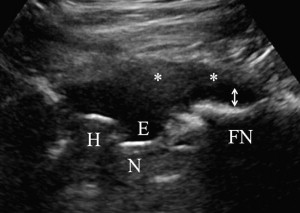
The sonographic evaluation of joint effusion can be confounded by hypoechoic synovial thickening, mimicking an effusion, and by a hyperechoic effusion caused by debris, thus mimicking synovial thickening. Although color or power Doppler sonography may distinguish actively inflamed synovitis from an effusion, the technique does not work for inactive synovitis.
Beyond the presence of an effusion, ultrasound is limited in its ability to diagnose intra-articular pathologic conditions. Connell and colleagues reported normal hip sonograms in patients in whom magnetic resonance (MR) imaging revealed degenerative arthrosis, labral abnormalities, and avascular necrosis.
Anecdotally, an advanced degenerative change may be detected sonographically by the presence of subcapital osteophytes or loss of normal femoral head sphericity ( Fig. 3 ). Labral tears may be seen sonographically as a hypoechoic cleft through the echogenic fibrocartilaginous labrum or as detachment of the echogenic labrum from the bone ( Fig. 4 ). Sofka and colleagues reported that the intra-articular injection of fluid, as during a cortisone injection, had a sono-arthrographic effect, making labral tears more conspicuous, but the sensitivity and specificity of ultrasound for labral tears have not yet been reported. In a meta-analysis of the literature, Smith and colleagues found that MR imaging had a sensitivity of 66% and a specificity of 79% for labral tears, whereas MR arthrography had a sensitivity of 87% and specificity of 64%, with less reader variation in the sensitivity and specificity of the MR arthrography studies.
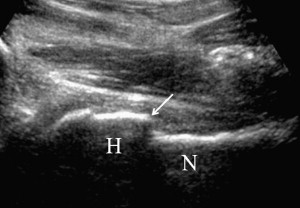
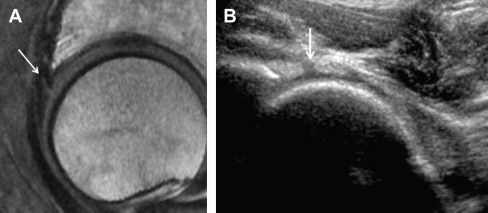
Perilabral cysts are seen sonographically as well-defined anechoic collections adjacent to the labrum, and on MR imaging they are seen as focal T2 hyperintense lesions ( Fig. 5 ). Currently there is a lack of data on the sensitivity and specificity of both ultrasound and MR imaging for the diagnosis of labral cysts.
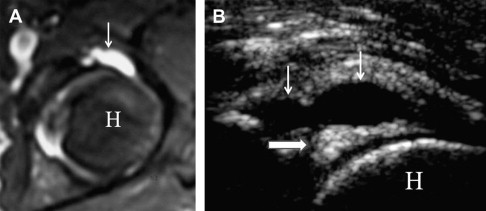
In addition to the usual disadvantages of MR imaging, such as time and cost, the prosthetic hip has the added disadvantage of artifact arising from the metal. Although advances in MR imaging have made the evaluation of the prosthetic hip possible, some artifact does remain and not all centers have access to these advanced sequences. Although sonography is not hampered by a prosthesis, the modality does not allow for a global assessment of the region and cannot penetrate bone. Osteolysis is difficult to image on ultrasound until it is very advanced. MR imaging has been shown to be the most sensitive modality for the detection of osteolysis, with a sensitivity of 95% in cadaveric studies.
Sonography can guide therapeutic injections and diagnostic aspirations of the hip joint ( Fig. 6 ). Smith and colleagues compared the accuracy of ultrasound-guided hip injection to that of fluoroscopic injection and found that, in 29 of 30 patients, the needle was placed accurately using ultrasound.
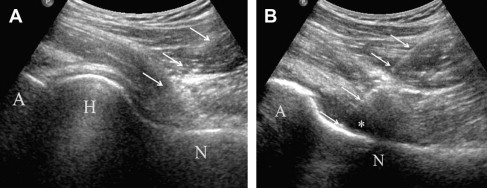
Intra-articular evaluation
A hip joint effusion is one of the most common signs of pathologic conditions in both the native and prosthetic hip, but what constitutes an effusion in terms of capsular distention is debated. Koski defined capsular distention as 7 mm or more, measuring the distance between the femoral neck and the anterior joint capsule, or a difference of 1 mm between both hips as a joint effusion. Bierma and colleagues found a higher correlation with clinical symptoms using the criterion of 1-mm difference in capsular distention between hips. This finding was true even when using the higher measure for joint effusion of 9 mm as defined by Sada and colleagues, who found 9 mm was the largest measurement in their study of 110 healthy adults. Sada and colleagues found a mean difference of 0.42 mm between hips in their healthy adult population.
Measurements of effusion in symptomatic hips in children have ranged from 4.7 mm to 9.9 mm. Tien and colleagues measured the synovial recesses of both hips in 748 healthy kindergarten-aged children and found that the measurements differed depending on patient positioning and used a standardized extended hip and knee position. In this position, they found a mean difference in the same child of 0.61 ± 0.52 mm. Because 95% of the differences should be 1.46 mm or less in their study, they concluded that if the difference between hips is greater than 1.46 mm, joint effusion should be highly suspected ( Fig. 1 ).
Tarasevicius and colleagues studied 27 patients undergoing arthroplasty measuring from the anterior neck of the femoral component to the anterior wall of the joint capsule. At 6 months in patients who had undergone posterior soft tissue repair, the recess measured 1.695 cm (SD 0.25 cm). In patients who had not undergone posterior soft tissue repair, it measured 1.347 cm (SD 0.30 cm). After 12 months, the median capsular distension was 1.406 cm (SD 0.33 cm) and 1.202 cm (SD 0.36 cm), ( P = .11), respectively. Földes and colleagues reported a sensitivity of 92.8% and a specificity of 83.3% for ultrasound in the detection of an effusion following hip arthroplasty in 55 patients, 25 of whom had pain ( Fig. 2 ).
The sonographic evaluation of joint effusion can be confounded by hypoechoic synovial thickening, mimicking an effusion, and by a hyperechoic effusion caused by debris, thus mimicking synovial thickening. Although color or power Doppler sonography may distinguish actively inflamed synovitis from an effusion, the technique does not work for inactive synovitis.
Beyond the presence of an effusion, ultrasound is limited in its ability to diagnose intra-articular pathologic conditions. Connell and colleagues reported normal hip sonograms in patients in whom magnetic resonance (MR) imaging revealed degenerative arthrosis, labral abnormalities, and avascular necrosis.
Anecdotally, an advanced degenerative change may be detected sonographically by the presence of subcapital osteophytes or loss of normal femoral head sphericity ( Fig. 3 ). Labral tears may be seen sonographically as a hypoechoic cleft through the echogenic fibrocartilaginous labrum or as detachment of the echogenic labrum from the bone ( Fig. 4 ). Sofka and colleagues reported that the intra-articular injection of fluid, as during a cortisone injection, had a sono-arthrographic effect, making labral tears more conspicuous, but the sensitivity and specificity of ultrasound for labral tears have not yet been reported. In a meta-analysis of the literature, Smith and colleagues found that MR imaging had a sensitivity of 66% and a specificity of 79% for labral tears, whereas MR arthrography had a sensitivity of 87% and specificity of 64%, with less reader variation in the sensitivity and specificity of the MR arthrography studies.
Perilabral cysts are seen sonographically as well-defined anechoic collections adjacent to the labrum, and on MR imaging they are seen as focal T2 hyperintense lesions ( Fig. 5 ). Currently there is a lack of data on the sensitivity and specificity of both ultrasound and MR imaging for the diagnosis of labral cysts.
In addition to the usual disadvantages of MR imaging, such as time and cost, the prosthetic hip has the added disadvantage of artifact arising from the metal. Although advances in MR imaging have made the evaluation of the prosthetic hip possible, some artifact does remain and not all centers have access to these advanced sequences. Although sonography is not hampered by a prosthesis, the modality does not allow for a global assessment of the region and cannot penetrate bone. Osteolysis is difficult to image on ultrasound until it is very advanced. MR imaging has been shown to be the most sensitive modality for the detection of osteolysis, with a sensitivity of 95% in cadaveric studies.
Sonography can guide therapeutic injections and diagnostic aspirations of the hip joint ( Fig. 6 ). Smith and colleagues compared the accuracy of ultrasound-guided hip injection to that of fluoroscopic injection and found that, in 29 of 30 patients, the needle was placed accurately using ultrasound.
Bursitis and extracapsular fluid collections
There are 3 major bursae about the hip: the greater trochanteric bursa, the iliopsoas bursa, and the ischial bursa. The greater trochanteric bursa, also called the subgluteus maximus bursa, is located immediately posterior to the posterior facet of the greater trochanter, the lateral insertion of the gluteus medius tendon, and the proximal part of the vastus lateralis. The iliopsoas bursa is the largest bursa in the body. It lies between the joint capsule and the medial tendinous portion of the iliacus muscle and extends from the level of the inguinal ligament to just above the lesser tuberosity. Under normal circumstances, it communicates with the hip in 15% of the population. The ischial bursa lies deep to the inferior portion of the gluteus maximus muscle and posteroinferiorly to the ischial tuberosity.
In the native hip, bursitis is most often mechanical, although it can occur secondary to infection or arthritis. Trochanteric bursitis is thought to most often occur because of friction during hip flexion and extension. It is most commonly seen in the elderly but can also be seen in athletes and overuse. Ischial bursitis occurs most often from direct trauma but can also occur from prolonged sitting, particularly if there is vibration associated with sitting such as is seen in tractor or machinery operators. Iliopsoas bursitis is most commonly seen in overuse syndromes that require hip flexion, such as in athletes, particularly in uphill runners, or in occupational overuse from heavy lifting. It can also occur in inflammatory arthropathies, such as rheumatoid or from impingement at the hip joint by osteophytes.
In the prosthetic hip, iliopsoas bursitis can be seen in the setting of friction of the tendon over a prominent acetabular cup or decompression from the joint in adverse tissue reactions ( Fig. 7 ). Trochanteric bursitis in the postoperative hip is uncommon but can occur from mechanical causes, such as if the biomechanics of gait are changed, or as an extension of an intra-articular process, such as infection, particle disease, or adverse local tissue reaction ( Fig. 8 ).

Stay updated, free articles. Join our Telegram channel

Full access? Get Clinical Tree



